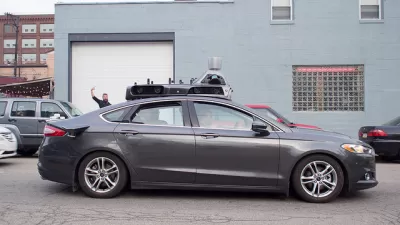Remember Elaine Herzberg, the 49-year-old woman who became the first pedestrian fatality due to an autonomous vehicle when she was hit last March by an Uber with a safety driver in Tempe, Ariz.? Prosecutors found no criminal liability.
Herzberg had stepped off a center median mid-block, walking her bicycle into a lane of traffic at 10 pm on March 18 when she was struck by the Volvo XC90 SUV test vehicle traveling 38 mph, three miles per hour over the speed limit.
The Tempe Police had initially determined the crash may have been unavoidable, just the type of incident that autonomous technology is supposed to prevent had it been working properly, which it deliberately wasn't (see below).
"The Yavapai County Attorney’s Office, which reviewed the case [at the request of the Maricopa County Attorney’s Office, which had a potential conflict of interest in the case], said in a letter dated Monday [March 4] that there was 'no basis for criminal liability for the Uber corporation,'” reports Mihir Zaveri for The New York Times.
The incident placed the spotlight not only on self-driving technology but the human "testers" that are supposed to perform as a safety check should the autonomous technology fail.
In June, the Tempe Police Department released a report that said the safety driver was streaming the television show “The Voice” on her phone in the minutes leading up to the crash, The Arizona Republic reported.
Disabled automatic braking technology
A preliminary National Transportation Safety Board report about the crash adopted on May 24 found that "a built-in emergency braking system had been disabled while the car was in autonomous mode to ensure a smoother ride," reported Daisuke Wakabayashi for The Times.
A recent post on the increase in pedestrian fatalities last year also included test results from the Insurance Institute for Highway Safety, Highway Loss Data Institute on automatic emergency braking systems that can detect and brake for pedestrians. The technology worked well for 9 of 11 SUVs equipped with the technology.
"The NTSB preliminary report "also affirmed what many experts on self-driving cars said in the days after the crash: Uber’s cars are loaded with sensors and cameras that should have detected a pedestrian with plenty of time to stop," added Wakabayashi.
But this one failed through a combination of a computer system not responding properly to the pedestrian’s presence and a distracted safety driver.
Video not conclusive
"Based on the entire investigation, this Office has concluded that the collision video, as it displays, likely does not accurately depict the events that occurred," states the letter [pdf] from the Yavapai County Attorney's office.
"Bryant Walker Smith, a University of South Carolina law professor whose research focuses on automated driving systems, suggests not reading too much into the prosecutor's letter," reports Laurel Wamsley for NPR.
"It's not necessarily exculpatory — it doesn't exonerate Uber or put the company's conduct then or now beyond criticism," he writes in an email to NPR. "And I'm not sure it tells us much about the criminal, much less civil, liability of automated driving developers in future incidents."
Hat tip to Streetsblog California.
FULL STORY: Prosecutors Don’t Plan to Charge Uber in Self-Driving Car’s Fatal Accident

Alabama: Trump Terminates Settlements for Black Communities Harmed By Raw Sewage
Trump deemed the landmark civil rights agreement “illegal DEI and environmental justice policy.”

Planetizen Federal Action Tracker
A weekly monitor of how Trump’s orders and actions are impacting planners and planning in America.

Why Should We Subsidize Public Transportation?
Many public transit agencies face financial stress due to rising costs, declining fare revenue, and declining subsidies. Transit advocates must provide a strong business case for increasing public transit funding.

Understanding Road Diets
An explainer from Momentum highlights the advantages of reducing vehicle lanes in favor of more bike, transit, and pedestrian infrastructure.

New California Law Regulates Warehouse Pollution
A new law tightens building and emissions regulations for large distribution warehouses to mitigate air pollution and traffic in surrounding communities.

Phoenix Announces Opening Date for Light Rail Extension
The South Central extension will connect South Phoenix to downtown and other major hubs starting on June 7.
Urban Design for Planners 1: Software Tools
This six-course series explores essential urban design concepts using open source software and equips planners with the tools they need to participate fully in the urban design process.
Planning for Universal Design
Learn the tools for implementing Universal Design in planning regulations.
Caltrans
Smith Gee Studio
Institute for Housing and Urban Development Studies (IHS)
City of Grandview
Harvard GSD Executive Education
Toledo-Lucas County Plan Commissions
Salt Lake City
NYU Wagner Graduate School of Public Service




























